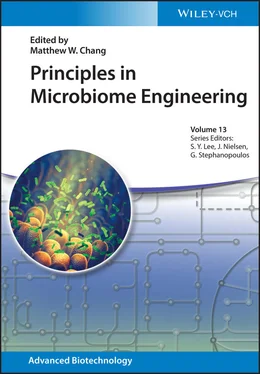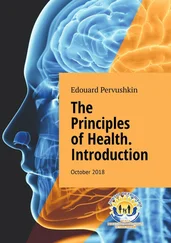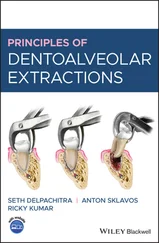Principles in Microbiome Engineering
Здесь есть возможность читать онлайн «Principles in Microbiome Engineering» — ознакомительный отрывок электронной книги совершенно бесплатно, а после прочтения отрывка купить полную версию. В некоторых случаях можно слушать аудио, скачать через торрент в формате fb2 и присутствует краткое содержание. Жанр: unrecognised, на английском языке. Описание произведения, (предисловие) а так же отзывы посетителей доступны на портале библиотеки ЛибКат.
- Название:Principles in Microbiome Engineering
- Автор:
- Жанр:
- Год:неизвестен
- ISBN:нет данных
- Рейтинг книги:5 / 5. Голосов: 1
-
Избранное:Добавить в избранное
- Отзывы:
-
Ваша оценка:
- 100
- 1
- 2
- 3
- 4
- 5
Principles in Microbiome Engineering: краткое содержание, описание и аннотация
Предлагаем к чтению аннотацию, описание, краткое содержание или предисловие (зависит от того, что написал сам автор книги «Principles in Microbiome Engineering»). Если вы не нашли необходимую информацию о книге — напишите в комментариях, мы постараемся отыскать её.
Provides an overview of the techniques and applications insight into the complex composition and interactions of microbiomes Principles in Microbiome Engineering
Principles in Microbiome Engineering
Principles in Microbiome Engineering — читать онлайн ознакомительный отрывок
Ниже представлен текст книги, разбитый по страницам. Система сохранения места последней прочитанной страницы, позволяет с удобством читать онлайн бесплатно книгу «Principles in Microbiome Engineering», без необходимости каждый раз заново искать на чём Вы остановились. Поставьте закладку, и сможете в любой момент перейти на страницу, на которой закончили чтение.
Интервал:
Закладка:
1.1.2.1 Prebiotics
Prebiotics comprise mainly specialized plant fibers that play a role in enhancing the proliferation of selected groups of microbes. These fibers can exist as both soluble and non‐soluble fibers, where they function to retain and stabilize certain microbial populations. The role of prebiotics is most prominent in the GI tract, where the addition of prebiotics enhances glucose metabolism and reduces the risk of developing metabolic diseases such as diabetes and obesity [46, 47].
1.1.2.2 Probiotics
Probiotics are live beneficial microbes that supplement certain health‐benefiting functions lacking in the human host [48, 49]. To qualify as a probiotic, the microbes must be resistant to gastric juices and bile acids, compete with the local microbiota, and localize in the gut for a short period, on top of having health‐benefiting properties [50]. There have been extensive studies suggesting that probiotics confer health‐benefiting properties [51] and alleviate negative side effects of antibiotic‐associated diarrhea [52]. There are various probiotics from different phyla, such as Lactobacillus sp. and Bacillus coagulans ( Firmicutes ), Bifidobacterium ( Actinobacteria ), E. coli Nissle 1917 ( Proteobacteria ), and Saccharomyces boulardii (Ascomycota). It is well documented that certain probiotics such as E. coli Nissle 1917, S. boulardii, and certain Lactobacilli have been used to treat gastrointestinal infections and gut‐related complications [48]. Spore‐forming bacilli such as B. coagulans were used to treat rheumatoid arthritis through gut‐mediated anti‐inflammatory properties [50]. Other studies have also shown that S. boulardii have been used to treat skin wound infections, while Lactobacilli are commonly used to maintain healthy vaginal flora to prevent bacterial vaginosis (BV).
1.1.2.3 Diet and Nutrition
The dietary habits and nutritional composition influence the microbiome, thus affecting the host health. The food distribution based on living standards, the supply of local foods, and cultural habits influence people's dietary habits from different walks of life. In the consumption of these food groups, the nutritional content alters the preference of microbial growth in the GI tract. This diversity is time‐dependent, where the microbiome profile is highly dynamic providing daily cyclical fluctuations that are influenced by the eating habits and daily routine [53]. For instance, individuals consuming a meat‐rich diet showed an increased diversity of bile‐tolerant microorganisms ( Alistipes, Bilophila , and Bacteroides ). They decreased polysaccharide hydrolyzing‐ Firmicutes compared to the vegetarian diet [54]. Comparatively, intermittent fasting in mice showed cyclical changes in the gut microbiome, affecting all major phyla where Firmicutes peaks during nocturnal feeding, whereas Bacteroidetes and Verrucomicrobia species peaked during daytime feeding [53].
These dietary patterns indicate the roles of diet affecting the gut microbiome, where this topic would be further discussed in the following sub chapter 1.2.
1.1.3 Current Approaches Employed in Studying the Human Microbiome
As mentioned in the introduction, the era of multi‐omics studies propelled microbiome research with the advancement in 16S ribosomal RNA sequencing and shotgun metagenomic sequencing technologies. This gave rise to big data analysis of bioinformatics data acquired from donors of various backgrounds and health states, providing various new platforms to accelerate the analysis of large datasets, such as gcMeta [55] and MicrobiomeAnalyst [56].
Employing 16S rRNA gene sequencing enables the profiling of most prokaryotic amplicons that accurately classify and identify prokaryotes on a routine basis [57, 58], providing a reliable evidence to support phylogenetic study [59]. On the other hand, shotgun metagenomic sequencing provides a closer understanding of the total genomic DNA makeup of an isolated microbe. This approach provides the complete profiling of the isolated microbe to investigate the unique traits of the microbes and its role in the microbiome (e.g. metagenomic assembly and binning, metabolic function profiling, and antibiotic resistance gene profiling) [60, 61].
These technologies provide researchers with a glimpse of the gut microbiome composition, facilitating research breakthroughs on the role of each individual microbial group and their roles in a state of equilibrium. The prospect is optimistic, but further refinement of the technique is needed to understand the many unclassified components of the microbiome that has yet to be annotated.
1.2 Dietary Lifestyle Variation Affecting Host Microbiome
In section 1, we have introduced that dietary nutritional content impacts human gut microbiota including up to 10 14anaerobic microorganisms from over 1,000 different species [62]. While it is certain that diet plays an important role in shaping the microbiome, however, the differing lifestyle is a major determining factor in influencing the dietary pattern. This section will first look at the role of nutrition influencing the gut microbiome, followed by a closer inspection on the dietary differences of individuals of different wealth, ages and locality.
1.2.1 Dietary Role in Shaping the Microbiome
Dietary habits and nutritional composition are a few of the most important and modifiable determinants of human health. Habitual diet is postulated as an essential determinative factor to establish the initial human gut microbiome. Among them, carbohydrates, fat, protein, vitamin, water, and inorganic salt are the six major nutrients needed by the human body. While it is certain that each of these major nutrients plays an important role in shaping the microbiome, other factors synergistically exert their influence such as gender, body mass index (BMI), cultural, economic, social socioeconomic status, and lifestyle (e.g. smoking, alcohol drinking, and physical activity) [63]. The intake of these dietary nutrients facilitates various cellular functions such as tissue repair, homeostatic biochemical equilibrium, and host development. These cellular activities are not just limited to the host cellular response to the nutrient abundance but are also dependent on the microbiota response to these nutrients, altering the population and behavior of individual microbial groups. Herein, we discuss the role of protein, soluble saccharides, fibrous insoluble polysaccharides, and lipids in shaping the microbiome.
1.2.1.1 Protein and Polypeptides
The high nitrogenous content of dietary protein and peptides provides amino acids essential to both the host biochemistry and its microbiota. Most organisms require the essential 20 different amino acids to facilitate their cellular function [64]. The human host–microbiome favors the retention of certain microbiota population that helps break down protein complexes, providing the host with better absorption of these digested protein products. Some of these microbes thrive in the small intestine, such as Klebsiella spp. , E. coli, Streptococcus spp. , Succinivibrio dextrinosolvens, Mitsuokella spp. , and Anaerovibrio lipolytica, which secretes various proteases and peptidases to facilitate protein digestion in the human gut [65].
High‐dietary protein can change the microbiota composition by favoring microbes that can metabolize exogenous proteins. Certain microbes from the genus Bacteroides and Lactobacillus johnsonii naturally secrete proteases to digest dietary proteins and facilitate microbial localization in the small intestine [66]. These microbes establish a form of commensalism with the host, where the digested amino acids are utilized both by the microbe and human host via absorption through the intestinal epithelial tissue. Microbiome dysbiosis caused by protein deficiency, such as a vegetarian diet, results in the depletion of protein‐metabolizing populations and triggering intestinal inflammation [67].
Читать дальшеИнтервал:
Закладка:
Похожие книги на «Principles in Microbiome Engineering»
Представляем Вашему вниманию похожие книги на «Principles in Microbiome Engineering» списком для выбора. Мы отобрали схожую по названию и смыслу литературу в надежде предоставить читателям больше вариантов отыскать новые, интересные, ещё непрочитанные произведения.
Обсуждение, отзывы о книге «Principles in Microbiome Engineering» и просто собственные мнения читателей. Оставьте ваши комментарии, напишите, что Вы думаете о произведении, его смысле или главных героях. Укажите что конкретно понравилось, а что нет, и почему Вы так считаете.












